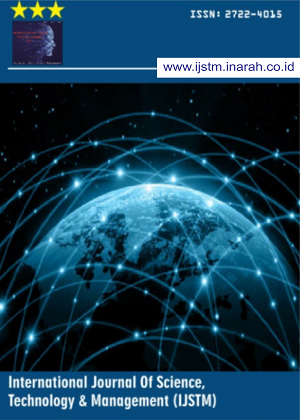Effect Of Additional Probiotic In Cattle Feed On Cattle's Consumption And Growth Rate
Abstract
This study aimed to determine the level of feed consumption, weight gain of cattle, and to calculate the
population of lactic acid bacteria (LAB) and pathogenic bacteria Escherichia coli and Salmonella in
cattle feces in order to determine the effect of giving probiotics on the digestive system of cattle. The
research object used was 10 bali cattle with a weight of about 90-120 kg. The data in this study were
analyzed by experimental design using analysis of variance to determine the effect of giving probiotics to
cattle feed on cattle weight gain. The treatment in question includes G0 with treatment in the form of
feeding with a composition of 60% forage, 15% palm cake, 25% cassava, and 100 ml molasses.
Meanwhile, G1 was treated with the same feed as G0, but added with 100 ml of probiotic Probio_FM.
Based on the results of the study, it is known that probiotics given to cattle feed showed no significant
effect on the level of feed consumption and body weight of cattle where cattle with non-probiotic feed had
a higher average consumption level than cattle on probiotic feed. Furthermore, this causeed the average
weight gain of non-probiotic cattle to be higher than that of probiotic cattle. In addition, it was known that
the population of Lactic Acid Bacteria in the feces of probiotic cattle showed a higher number of LAB
colonies compared to non-probiotic cattle with numeric values of 3.6x108
, 3.3x109
, and 2.7x1010. This
proved that giving probiotics to bali cattle with a concentration of 100 ml / 100 kg of feed was able to
increase the concentration of lactic acid bacteria in the digestive system.
Downloads
References
Adriani. 2009. Pengaruh Pemberian Probiotik dalam Pakan terhadap Pertambahan Bobot Badan Kambing
Kacang. Jurnal ilmiah ilmu-ilmu peternakan. XII (1).
Ambari, M. Z., Surono dan Sutrisno. 2018. Pengaruh pakan komplit dengan level NDF berbeda yang
mengandung probiotik isi rumen kerbau pada domba terhadap nilai kecernaan dan TDN. Prosiding Simposium
Nasional “Inovasi Teknologi Peternakann Menyong-song Era Industri 4.0”. Yogyakarta, 5 November 2018.
Universitas Gadjah Mada, Yogyakarta. Hal. 40 – 44.
Anggorodi, R. 1994. Ilmu Makanan Ternak Umum. PT Gramedia, Jakarta.
Antara. 2021. Babel Dorong Penggemukan Sapi di Belitung. Artikel. Dikutip pada 22 Desember 2021 dari:
https://www.google.com/amp/s/m.medcom.id/amp/MkMdZmvb-babeldorong-penggemukan-sapi-dibelitung?espv=1
Aritonang, S.N., Roza Elly., dan Rossi Evy. 2019. Probiotik dan Prebiotik : Dari Kedelai untuk Pangan
Fungsional. Indomedia Pusaka : Sidoarjo.
Astuti F. K., Busono W., dan Sjofjan O. 2015. Pengaruh Penambahan Probiotik Cair dalam Pakan Terhadap
Penampilan Produksi Ayam Pedaging. J-PAL. 6 (2) : 99-104.
Azizah N. K. et al., 2020. Pengaruh Probiotik Bakteri Asam Laktat dalam Air Minum Terhadap Konversi Pakan
Ayam Boiler. Journal of Basic Medicak
Veterinity. 9 (2) : 86-91.
Candra A. A dan Magfiroh K. 2018. Meningkatkan Penampilan Broiler dengan Pemacu Pertumbuhan Alami.
Jurnal Peternakan Terapan. 1 (1) : 11-15.
Harimurti, S; E. S. rahayu., Nasroedin, Kurniasih. 2005. Bakteri asam laktat dari intestin ayam sebagai agensia
probiotik. Animal Production. 9 (2) : 82-91.
Kementerian Pertanian RI. 2021. Kementan Apresiasi Program Integrasi SapiSawit Provinsi Bangka Belitung.
Dikutip pada 22 Desember 2021 dari : https://www.pertanian.go.id/home/?show=news&act=view&id=3952
International Journal Of Science, Technology & Management ISSN: 2722-4015
Lambert, J. and R. Hull. 1996. Upper gastrointestinal tract disease and probiotics. Asia Pacific J Clin Nutr. 5(1):
-35.
Marhaeniyanto, E. dan S. Susanti. 2011. Strategi suplementasi leguminosa untuk meningkatkan penampilan
domba. Buana Sains. 11 (1): 7–16.
Scott, M. L., M. C. Nesheim, dan R. J. Young. 1982. Nutrition of The Chicken. 3rd ed. Ithaca, N.Y. : M. L.
Scott.
Suwito, W. 2009. Dampak verotoksigenik dan enterohemoragik Escherichia coli (VTEC dan EHEC) pada
hewan, manusia dan makanan. Wartazoa. 19 (2) : 7.
Gunawan dan M.M.S. Sundari. 2003. Pengaruh Penggunaan Probiotik dalam Ransum terhadap Produktivitas
Ayam. Wartazoa. 13(3): 92-98.
Novel , S. S. dan R. Safitri. 2009. Manfaat Bakteri Probiotik untuk Kesehatan Manusia. Medicinus. 22(3): 122-
Purwanti, D., Suryahadi, D., Evvyernie. 2014. Performa Sapi Potong Sebagai Respon Dari Suplementasi
Probiotik Padat dan Cair. Buletin Makanan Ternak. 101 (1) : 13 – 24.
Zain, N.W.H., dan Harahap, A.E. 2015. Kuantitas dan Kualitas Bakteri Asam Laktat yang Diisolasi dari Cairan
Rumen sebagai Sumber Probiotik. Prosiding Seminar Nasional Teknologi Peternakan daan Veteriner. 157 – 163.





























